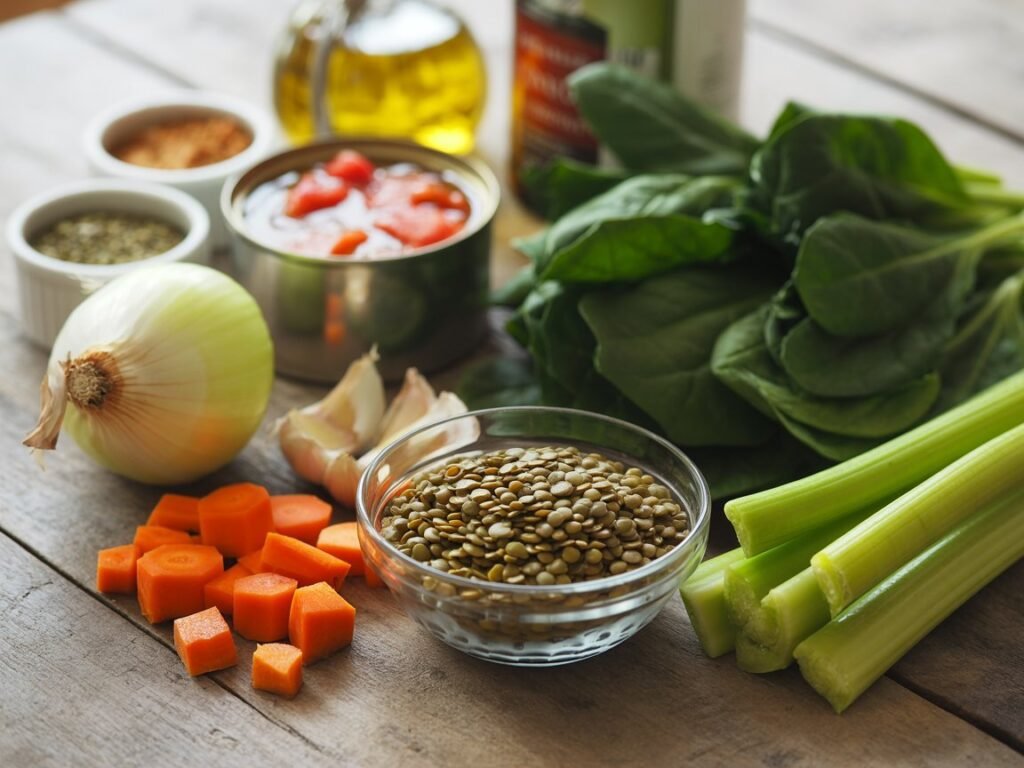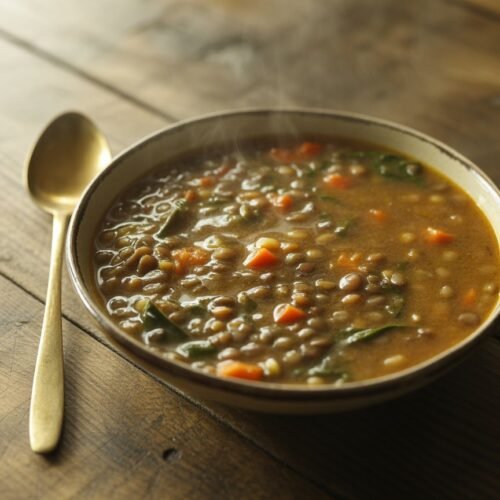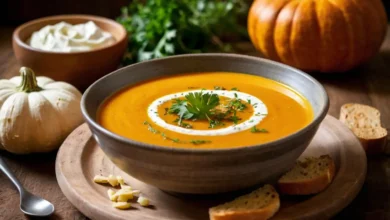
Hearty Vegan Lentil Soup
Vegan freezer meals are a practical and popular solution for busy individuals seeking efficient, nutritious, and cost-effective meal options. By preparing these meals in advance, people can save time, maintain a healthy diet, reduce reliance on unhealthy convenience foods, and easily access wholesome, satisfying dishes throughout the week.
Table of Contents
Why This Dish is a Must-Try
- Budget-Friendly: This recipe utilizes staple ingredients that are affordable and readily available. By making a large batch, you can save money while minimizing food waste, allowing for efficient meal planning without breaking the bank.
- Packed with Nutrients: Loaded with vegetables, legumes, and whole grains, this dish is designed to provide an array of essential nutrients. Each serving is rich in vitamins, minerals, fiber, and protein, making it a wholesome option for vegans and non-vegans alike.
- Easily Customizable: One of the greatest advantages of this recipe is its versatility. You can modify ingredients based on seasonal produce or personal tastes. Whether you prefer to spice it up with more heat or add a variety of fresh herbs, the options are endless.
- Suitable for Various Dietary Restrictions: In an increasingly diverse culinary world, this meal caters to a range of dietary preferences. It is naturally gluten-free, oil-free, and can be adapted for those avoiding specific allergens.
Ingredients and Instructions for Hearty Vegan Lentil Soup
To prepare a versatile and nutritious vegan freezer meal, the following ingredients will be necessary. These ingredients are commonly found in supermarkets across the United States and provide a robust foundation for a variety of dishes. For a basic lentil stew, you will need the following items:
Hearty Vegan Lentil Soup Recipes
Ingredients
- 1 cup dried green or brown lentils
- 1 medium onion diced
- 2 cloves garlic minced
- 2 medium carrots diced
- 2 celery stalks diced
- 1 can 14 oz diced tomatoes
- 4 cups vegetable broth
- 1 teaspoon dried thyme
- 1 teaspoon ground cumin
- Salt and pepper to taste
- 2 tablespoons olive oil
- 2 cups leafy greens such as spinach or kale
Instructions
- Start by rinsing the lentils under cold water to remove any impurities. This step is crucial for achieving the best flavor.
- In a large pot, heat the olive oil over medium heat. Once hot, add the diced onion, cooking until translucent, approximately 5 minutes.
- Add the minced garlic, diced carrots, and celery to the pot. Cook for an additional 5 minutes, allowing the vegetables to soften.
- Stir in the rinsed lentils, diced tomatoes (with their juices), vegetable broth, dried thyme, and ground cumin. Season with salt and pepper according to your preference.
- Bring the mixture to a boil. Once boiling, reduce the heat to low and cover the pot. Let it simmer for about 25-30 minutes or until the lentils are tender.
- Just before serving, stir in the leafy greens of your choice, allowing them to wilt into the stew. This not only enhances nutrition but also adds a vibrant color to the dish.
- Once fully cooked, allow the stew to cool before portioning it into freezer-safe containers. Label them with the date and contents for easy identification later.
How to Prepare: Step-by-Step Guide
Preparing vegan freezer meals requires organization and a clear understanding of the process to ensure the dishes are both healthy and delicious. Here is a step-by-step guide to help you navigate the preparation of these meals:
- Gather Ingredients: Begin by collecting all necessary ingredients. This may include fresh vegetables, legumes, grains, and spices, ensuring they are plant-based and free from animal products. Using organic produce can enhance the flavor and health benefits of your meals.
- Prepare Your Workspace: Create a clean and efficient cooking environment. Make sure all tools and equipment, such as cutting boards and pots, are sanitized. This helps prevent cross-contamination and ensures a smooth cooking process.
- Chop and Measure: Prepping your ingredients by chopping vegetables and measuring out portions will save time during cooking. Invest in a good quality knife for even cuts, and use measuring cups for accuracy in recipes.
- Start Cooking: Follow the recipe closely, beginning with ingredients that take longer to cook such as grains or legumes. Cooking in batches can help efficiently manage the time spent in the kitchen, allowing you to maximize the number of meals prepared at once.
- Cool Before Freezing: Once the meals are cooked, allow them to cool entirely before packaging. This helps maintain the texture and flavor. Store meals in airtight containers or freezer bags to prevent freezer burn.
- Label and Date: Properly labeling each meal with the name and date ensures that you can quickly identify and use them later. Use waterproof markers for clarity and longevity.
- Store in Freezer: Organize your meals in the freezer, placing the newer meals towards the back. Keep a list of what you have on hand to quickly plan meals throughout the week.
Other Recipes You May Like :
Pro Tips and Hacks
- Focus on Flavor:
- Prioritize efficiency and flavor in your strategy.
- Maximize taste by generously using and adjusting seasonings, herbs (like garlic and onion), and aromatics (like ginger or lemon zest) before freezing.
- Streamline Preparation:
- Use batch cooking to save time: wash and chop all vegetables at once and store them.
- Choose versatile ingredients (e.g., beans, grains) that can be used across multiple recipes to simplify shopping and planning.
- Use the Right Tools:
- Invest in quality kitchen tools like sharp knives and a food processor for efficient prep.
- Utilize appliances like slow cookers and Instant Pots to prepare large quantities of food with minimal effort.
- Stay Organized:
- Always label and date your freezer meals with the dish name and reheating instructions.
- Use clear containers or bags and maintain an organized freezer to ensure meal rotation and minimize waste.
Essential Tools for This Recipe
- High-Speed Blender: This tool is critical for creating smooth sauces, soups, and smoothies. A high-speed blender ensures that all ingredients are thoroughly blended, allowing for a creamy texture that enhances the flavor of your vegan dishes.
- Food Processor: A food processor is indispensable for chopping vegetables, making salsas, or preparing doughs. Its versatility saves time and effort, particularly when working with large quantities of ingredients typically used in freezer meal prep.
- Heavy-Duty Cutting Board: A sturdy cutting board provides a safe and stable surface for chopping and slicing. Choosing a board made from durable materials will withstand repeated use, ensuring longevity and hygienic food preparation.
- Sharp Knives: Having a set of sharp knives is essential for efficiently cutting through fruits, vegetables, and other ingredients. A good chef's knife, pairing knife, and a serrated knife will cover most cooking needs.
- Measuring Cups and Spoons: Accurate measurement is key to recipes, especially when preparing freezer meals where portion sizes matter. Both dry and liquid measuring tools will help ensure that ingredients are proportioned correctly.
- Freezer-Safe Containers: To store your vegan meals adequately, invest in high-quality, freezer-safe containers. Airtight storage options, such as glass or BPA-free plastic, help preserve the flavors and textures of your dishes over time.
- Slow Cooker or Instant Pot: These appliances are excellent for making large batches of soups, stews, and grains. They not only save time on cooking but also allow for hands-off preparation, freeing you to focus on other meal prep tasks.
Tips for Success
Strategic Ingredient Use:
- Be flexible with ingredient substitutions; use frozen or alternative fresh vegetables with similar textures if an item is out of season.
- Prioritize seasonal ingredients for the best flavor and availability.
Optimal Cooking Techniques:
- Properly prepare legumes (soaking and cooking) to improve their texture and digestibility.
- Choose flavor-intensifying methods like sautéing or roasting over boiling to add depth, especially by caramelizing vegetables slightly.
Efficient Preparation:
- Cook in bulk and portion into individual servings before freezing to save time and ensure consistent quality.
- Use airtight containers or freezer bags to prevent freezer burn and maintain freshness.
- Label all containers with the date and meal type for efficient meal planning.
Maximizing Flavor:
- Season generously and experiment with herbs, spices, and condiments to add complexity to vegan dishes.
- Use marinades and sauces made in advance, adding them before freezing for an extra burst of flavor upon reheating.
Serving Suggestions and Pairing Options
To Elevate & Complement Your Meal:
- Add a Fresh Salad: Provide a refreshing contrast to hearty dishes with leafy greens, tomatoes, cucumbers, and bell peppers with a light vinaigrette or tahini dressing.
- Incorporate Whole Grains: Serve meals with sides like quinoa, brown rice, or farro to boost fiber, protein, and make the meal more satisfying.
For Creaminess & Flavor:
- Use Dips and Spreads: Accompany dishes with hummus or creamy avocado dip to add complementary flavors and a creamy texture.
- Add Plant-Based Dairy: Include plant-based cheeses or yogurt to introduce creamy textures that enhance the overall experience.
For Texture & Heartiness:
- Serve with Bread: Offer warm, crusty bread or pita to create a more wholesome and comforting meal.
- Sprinkle with Nuts/Seeds: Add a crunch and nutritional boost by sprinkling nuts or seeds on top of meals or salads.
To Enhance Flavor:
- Garnish with Fresh Herbs: Use cilantro, parsley, or basil to add a final burst of freshness.
- Season with Spices: Deepen the flavor profile with spices like cumin or smoked paprika.
Storage and Reheating Instructions
Proper Storage:
- Use Airtight Containers: Preserve quality by using airtight containers or heavy-duty freezer bags to prevent freezer burn.
- Label Everything: Clearly label each container with the dish name and preparation date for easy identification.
- Cool Before Freezing: Allow meals to cool to room temperature before freezing to minimize condensation and ice crystals.
- Remove Excess Air: Ensure there is minimal air in containers or bags to prevent the food from degrading.
- Portion Control: Freeze meals in single-serving sizes for convenient reheating and to avoid waste.
- Use a Vacuum Sealer: For optimal long-term storage, use a vacuum sealer to remove all excess air.
Proper Reheating:
- Thaw Safely: The best method is to thaw the meal overnight in the refrigerator before reheating.
- Reheat from Frozen: If short on time, you can reheat meals directly from frozen.
- Microwave Method:
- Use a microwave-safe dish.
- Cover with a lid or microwave-safe wrap.
- Heat on medium power.
- Stir occasionally for even heating.
- Oven Method:
- Preheat oven to 350°F (175°C).
- Cover the dish with foil.
- Bake for 20-30 minutes, or until heated through.
- Check Temperature: Always ensure the internal temperature of the food reaches 165°F (74°C) for safety before serving.
Health Benefits of the Recipe
- Rich in Vitamins: This dish is abundant in vital vitamins, particularly those derived from vegetables and legumes, such as vitamin A, C, and K. These vitamins are crucial for maintaining healthy skin, vision, and immune function, as highlighted by the National Institutes of Health (NIH.gov).
- High in Fiber: Made primarily from whole grains and legumes, this meal is an excellent source of dietary fiber. Consuming fiber-rich foods can enhance digestive health, help regulate blood sugar levels, and contribute to a feeling of fullness, as noted by the Centers for Disease Control and Prevention (CDC.gov).
- Low in Saturated Fats: The recipe is entirely plant-based, which means it is naturally low in unhealthy saturated fats that are commonly found in animal products. A reduced intake of saturated fats is linked to lower cholesterol levels and a decreased risk of heart disease, supported by evidence from the American Heart Association (Heart.org).
- Minerals and Antioxidants: Ingredients such as leafy greens, nuts, and seeds contribute significant amounts of essential minerals like magnesium and zinc, as well as antioxidants that combat oxidative stress in the body. These compounds are crucial for maintaining optimal health and can lower the risk of chronic diseases, according to research from the Harvard T.H. Chan School of Public Health (Harvard.edu).






